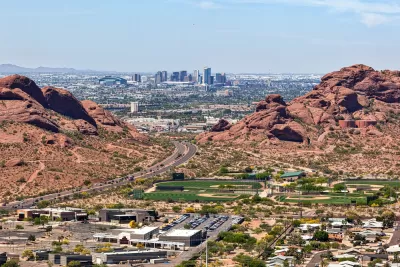The unique growth and challenges facing large cities in the U.S. Sun Belt will require a break from the kinds of policies generated to serve Northeastern and Midwestern cities over the course of U.S. history.

"That future can be seen now in the cities of the Urban Sun Belt — the 22 metropolitan statistical areas in the Sun Belt with a population of 1 million people or more," according to an article published by the Kinder Institute for Urban Research.
The article previews a new white paper from the Kinder Institute, titled "The Urban Sun Belt: An Overview," which "explores the interconnected opportunities and problems facing these large, young and quickly growing metro areas and how they differentiate them from the big cities of the Rust Belt and Coastal/Mountain regions of the U.S."
One of the prominent features of the biggest Sun Belt metropolitan areas is their quick growth, which includes quick growth in low-income populations. Meanwhile, affordability, a major selling point for many of these cities during the growth of recent decades, is slipping away.
For solutions to the challenges facing Sun Belt cities, the report suggests a new kind of urban policy, tailored to the unique qualities of those cities. "Many of the challenges facing the Urban Sun Belt are very specific to those metros. Making it more difficult to meet these challenges, according to the report, is the fact that most American urban policy is still crafted — and policy research is still conducted — with traditional Northeastern and Midwestern cities in mind," according to the article.
FULL STORY: Large, young and fast-growing Sun Belt metros need urban policy innovation

Alabama: Trump Terminates Settlements for Black Communities Harmed By Raw Sewage
Trump deemed the landmark civil rights agreement “illegal DEI and environmental justice policy.”

Planetizen Federal Action Tracker
A weekly monitor of how Trump’s orders and actions are impacting planners and planning in America.

Why Should We Subsidize Public Transportation?
Many public transit agencies face financial stress due to rising costs, declining fare revenue, and declining subsidies. Transit advocates must provide a strong business case for increasing public transit funding.

Understanding Road Diets
An explainer from Momentum highlights the advantages of reducing vehicle lanes in favor of more bike, transit, and pedestrian infrastructure.

New California Law Regulates Warehouse Pollution
A new law tightens building and emissions regulations for large distribution warehouses to mitigate air pollution and traffic in surrounding communities.

Phoenix Announces Opening Date for Light Rail Extension
The South Central extension will connect South Phoenix to downtown and other major hubs starting on June 7.
Urban Design for Planners 1: Software Tools
This six-course series explores essential urban design concepts using open source software and equips planners with the tools they need to participate fully in the urban design process.
Planning for Universal Design
Learn the tools for implementing Universal Design in planning regulations.
Caltrans
Smith Gee Studio
Institute for Housing and Urban Development Studies (IHS)
City of Grandview
Harvard GSD Executive Education
Toledo-Lucas County Plan Commissions
Salt Lake City
NYU Wagner Graduate School of Public Service




























